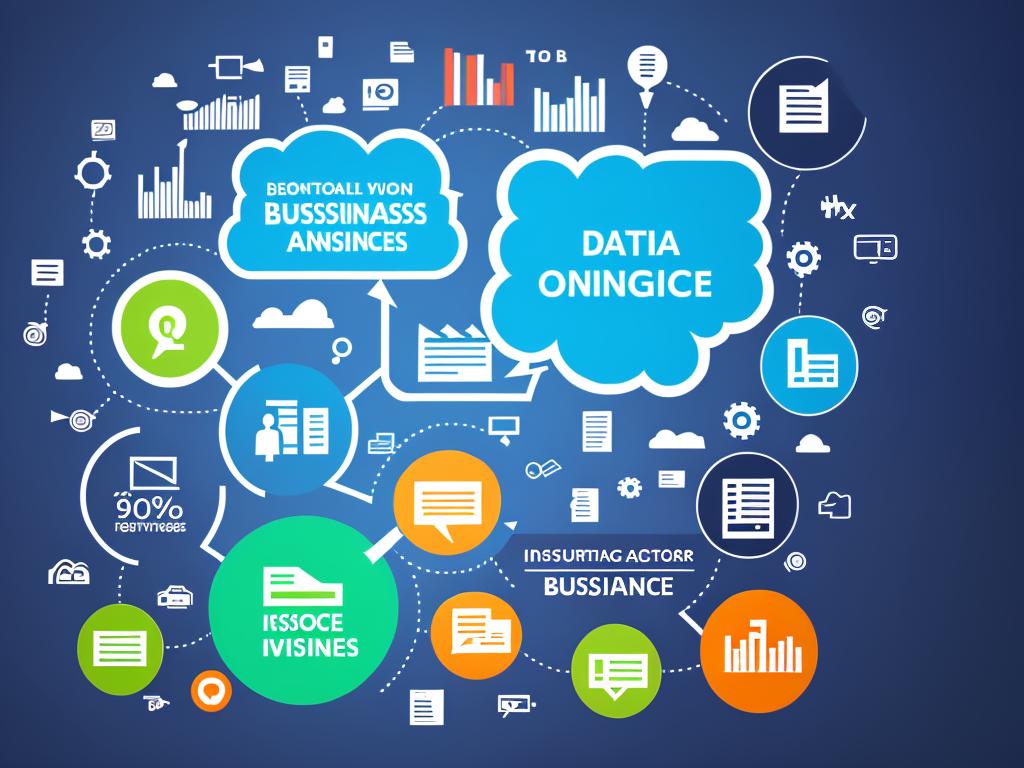The dynamic landscape of the business world has introduced the critical need for efficient tools in processing and analyzing vast amounts of data. The core aspect of this essay focuses on the effective integration of Business Intelligence (BI) in sales teams to improve data management, predict trends, and formulate effective strategies. This advantageous approach not only enhances the sales process’s efficiency but also allows for impactful decision making and strategic planning. The initiation of this discourse presents an overview of BI, its importance in modern businesses, and elaborates on how it impacts the sales process. Furthermore, its implementation and future trends in rapidly evolving technological dimensions are also comprehensively discussed.
Understanding Business Intelligence
Understanding Business Intelligence
Business Intelligence (BI) is a technology-driven process that transforms data into insightful information, enabling decision-makers to make informed, data-driven decisions. BI tools analyze and present information in an accessible format, such as charts, graphs, and dashboards, to provide actionable insights. These insights can be leveraged to improve business strategies and operations, including sales, customer service, marketing, and more.
Capabilities of Business Intelligence
BI tools come with several capabilities designed to assist businesses in understanding and interpreting their data. These include data visualization, data mining, querying, reporting, predictive analytics, and more. Data visualization tools enable data to be understood easily through graphs, charts, and dashboards. Data mining helps in identifying patterns and trends within large datasets. Querying allows users to ask specific questions from their data, and reporting provides comprehensive reports based on these queries. Predictive analytics uses historical data to predict future trends and behaviors.
Importance of Business Intelligence in Modern Businesses
In today’s data-driven economy, Business Intelligence is of critical importance. It enables companies to leverage the vast amounts of data they generate, transforming it into actionable insights. These insights can be used to identify new sales opportunities, monitor marketing campaigns, understand customer behavior, track performance, and make strategic decisions. BI helps to streamline operations, lower costs, and enhance productivity.
How Business Intelligence Works
Business Intelligence tools work by gathering data from different sources such as financial and operational systems, social media, and more. This data is then processed, cleaned up, and structured in a format that can be analyzed. BI tools subsequently conduct an analysis to derive insights, which are then presented in a user-friendly format that supports data-driven decision-making.
Business Intelligence and Data
The effectiveness of Business Intelligence tools largely depends on the quality of the data they have access to. Data utilized by BI tools can be both structured and unstructured and can come from a wide array of sources. Structured data is organized and can be easily analyzed – such as sales figures, while unstructured data like customer reviews and social media posts, present a much larger challenge for analysis because of their format.
Business Intelligence in Decision-making and Strategic Planning
BI plays a significant role in decision-making and strategic planning. By providing key insights from data, BI tools empower decision-makers with an evidence-based approach to decision-making. They help to expose trends and patterns, identify opportunities and threats, and measure performance against goals. It also aids strategic planning by offering predictive analytics capabilities, providing a more accurate prediction of market trends and customer behaviors, which in turn shapes business strategy.
Business Intelligence Tools for Sales Teams
Business Intelligence (BI) tools offer a considerable advantage to sales teams. These powerful resources provide the means for sales teams to scrutinize data, identify purchasing trends, highlight successful products or services, measure sales performance, and predict future sales trends. The invaluable insights derived from BI tools equip sales teams with the ability to make strategic decisions, increase sales efficiency, and enhance customer relationships—all vital components to driving sales and revenue upwards.

Insight into the Sales Process
Navigating the Sales Process
At the core of every business is its sales process – a detailed roadmap, followed by the sales team, to transform a potential lead into a budding customer. This tailored process is inherently unique to each company, painstakingly customized to its specific goals and target demographic. The process usually consists of seven stages: prospecting, initial contact, qualification, presentation of the offer, addressing objections, finalizing the sale, and post-sale follow-up. Within this framework, the sales team’s role is pivotal at every stage, from locating potential leads and initiating contact, to understanding the customer’s requirements, presenting the goods or services attractively, and ultimately bringing the transaction to a successful conclusion.
Integral to the sales process are sales targets – predefined objectives that the sales team strives to attain within a given timeframe. These targets function as a barometer for a company’s overall performance and trajectory of growth. The accomplishment of sales targets necessitates extensive planning, meticulous execution, and consistent tracking of ongoing progress.
Business Intelligence for Sales Teams
Business Intelligence (BI) tools can significantly enhance the efficiency and effectiveness of the sales process. BI tools offer automated data collection, data integration, data analysis, and data visualization capabilities that can provide invaluable insight into customer behaviors and trends, market conditions, and the company’s performance. This information helps sales teams make informed decisions and strategic adjustments in real time.
Using BI tools, sales teams can identify potential leads, assess their prospective value, and customize their approach for each prospect. As a result, the chances of converting prospects into customers increase. BI tools also help sales teams track their performance against set targets, enabling them to identify gaps and adjust their strategies accordingly.
Furthermore, BI tools can generate real-time reports that detail sales trends, conversion rates, and customer preferences. These data-driven insights fuel strategic decision-making, contributing to creating effective sales strategies and campaigns.
Optimizing Sales Procedures with Business Intelligence (BI) Tools
It is possible to elevate a company’s efficiency and simplify its operations by integrating Business Intelligence (BI) tools into their sales procedures. These tools mechanize a variety of manual tasks, thus allotting more time for sales teams to concentrate on the strategic facets of selling. They also consolidate management and analysis of data by offering a centralized platform, negating the need for multiple separate tools.
Furthermore, BI tools provide sales teams with the capability to perform data-based evaluations of their performance. This is achieved by juxtaposing actual performance against set targets, a process that identifies areas that are in need of improvement. The quick reactions and adaptability this enables is fundamental to reaching sales targets.
To sum up, Business Intelligence (BI) tools carry immense potential to transform sales procedures. They present practical insights and cultivate data-led decision-making processes, boosting the capacity of sales teams to effectively navigate the intricate aspects of selling. Hence, they are a strategic asset for any company aiming to regularly meet or surpass its sales targets.

Business Intelligence and Sales Teams
Deciphering Business Intelligence for Sales Teams
Business Intelligence, or BI, hints at processes propelled by technology and methodologies used in data analysis to generate practical directions. For sales teams, BI integrates data mining, data processing, performance benchmarking, data analytics, and reporting tools into a unified strategy aimed at enhancing sales outcomes and facilitating knowledgeable decisions.
BI Tools and Data Management
One of the primary ways BI assists sales teams is through data management. Sales departments are often loaded with data from disparate sources such as CRM systems, sales portals, and customer feedback channels. Managing and making sense of such diverse data can be a significant challenge. BI tools tackle this problem by consolidating all this data into a single, easy-to-understand platform, making it easier for sales teams to manage data and streamline operations.
Predicting Sales Trends with BI
Another significant benefit of BI in sales is its ability to predict trends and patterns. Using predictive analytics, BI tools can identify trends in a company’s sales data, helping teams to anticipate future outcomes. This feature allows sales teams to forecast market changes, prepare themselves for various scenarios, adapt their sales strategies accordingly, and ultimately stay ahead of the competition.
Formulating Sales Strategies with BI
Moreover, BI tools can assist sales teams in formulating effective sales strategies. For instance, by analyzing past sales data, these tools can reveal which sales techniques are working and which ones aren’t. Consequently, sales teams can optimize their strategies for better results. Additionally, BI insights can guide sales teams on where to concentrate their efforts, which products to promote, and which markets to penetrate.
Real-life Case Studies
Several companies have significantly enhanced their sales through BI. An excellent example is the multinational retail corporation Walmart. By utilizing BI systems, Walmart was able to analyze its customers’ behavior, preferences, and buying patterns. As a result, it could customize its marketing and sales strategies accordingly, increase customer satisfaction, and boost sales.
Amazon, the global e-commerce giant, is another example. Amazon uses BI tools to offer personalized product recommendations to its customers based on their past purchase history and browsing behavior. This personalized approach has significantly helped Amazon’s sales and customer retention.
Why Sales Teams Need Business Intelligence
In today’s competitive and rapidly changing business landscape, making data-driven decisions can be the key to increased profitability and productivity. This is where Business Intelligence (BI) for sales teams comes into play. BI empowers sales teams with improved data management, accurate sales forecasts, strategic planning capabilities, and personalized marketing strategies. The role and benefits of BI in modern sales operations are fundamentally significant.

Implementing Business Intelligence Tools
Navigating the Acquisition of Business Intelligence Tools
The journey towards effective use of Business Intelligence (BI) begins with the acquisition of appropriate tools. This process starts by identifying the needs of the sales team, which could include elements such as forecasting, report generation, data analytics, and pattern recognition. After defining these needs, research is then conducted to identify the best available BI tools in the market. Factors to consider in this decision-making include the tool’s compatibility with existing systems, the range of data sources it can handle, its user-friendliness, available customer support, training options, and of course, cost. Some of the frequently utilized BI tools by sales teams include Tableau, Power BI, and Microsoft Dynamics.
Setting Up Business Intelligence Tools
The setup phase is where the selected BI tool is installed and configured to the organization’s systems. This procedure includes server requirements, software installation, and the configuration of user profiles, permissions, and roles. If there are multiple data sources, the BI tool should connect and integrate with all of them to ensure a comprehensive data analysis.
Integration with Existing Systems
Integration involves making the new BI tool compatible with the existing sales systems and processes. The BI tool should be able to extract data from disparate sources and facilitate the creation of unified reports and dashboards that can be easily interpreted by the sales team. Integration ensures that there is no data redundancy and there’s efficient data management and usage.
Training Needs for Sales Staff
Training is critical in the process of implementing business intelligence tools. Regardless of the BI tool’s usability, the sales team needs to be trained on its effective use and apply the insights they gain positively in their decision-making processes. Training should not only cover the basics of using the tool but also the interpretation of data and using it to improve performance.
Challenges and How to Overcome Them
The successful implementation of BI tools in a sales team’s operations is not without challenges. These could range from data quality issues, data security and privacy concerns to resistance from employees.
Addressing data quality issues requires a systemic approach where missing, incorrect, or outdated data is identified and corrected or removed. On the other hand, ensuring data privacy and security can be achieved by adopting data encryption, two-factor authentication, and proper access controls.
Overcoming employee resistance requires open communication about the benefits of the BI tool and providing adequate training and support during the transition. Regular feedback and acknowledging those who adapt quickly to these changes can also encourage employee buy-in.
A Quick Overview
Adopting business intelligence tools requires careful steps in procurement, setup, integration, and training. As crucial as each one of these stages is, any lapse in meticulous planning and execution can result in outcomes that fall short of the anticipated potential. However, when implemented correctly, these business intelligence tools can spur remarkable improvements in the productivity and efficiency of sales teams.

Future Trends in Business Intelligence
The Intersection of AI and Machine Learning with Business Intelligence
There’s an unfolding trend in the realm of Business Intelligence (BI)—the integration of Artificial Intelligence (AI) and Machine Learning (ML). These technological advances equip businesses with the power to automate the analysis of intricate and voluminous data, thereby making the extraction of insights an efficient process. For sales teams, this translates into AI and ML-backed BI tools having the ability to forecast customer patterns, identify potential sales opportunities, and refine pricing strategies, among other advantages.
AI, in particular, broadens the scope of BI by undertaking complex analytical actions that are ordinarily laborious and time-consuming for humans. For example, AI has the ability to process data in both its structured and unstructured form—from ordinary spreadsheets to posts on social media platforms—to churn out insightful reports. Machine Learning, a branch of AI, also plays a pivotal role in BI. By unpicking patterns and trends from extensive data sets, Machine Learning can use this information to anticipate future scenarios.
Evolution of BI Tools
As technology advances, BI tools are also evolving. They are becoming more user-friendly, rooted in real-time reporting and capable of handling big data. For sales teams, modern BI tools mean they can now access crucial data anytime and anywhere, visualize data in various ways, interact with data, and gain real-time insights that inform their sales decisions.
Highly interactive dashboards, predictive analytics, and cloud technology are among the key features of the current and future BI tools that are particularly relevant to sales teams. Interactive dashboards allow sales reps to customize their view of data and focus on what is important to them. Predictive analytics is an integral part of BI as it helps sales teams to identify patterns and anticipate future sales trends. Cloud technology, on the other hand, provides mobility as it allows access to data and BI functions from any device, anywhere.
The Implications of BI Changes on Sales Teams
The evolution of BI tools and the shift towards AI and ML have significant implications for sales teams. On one hand, they can dramatically increase efficiency and productivity by automating routine tasks such as data gathering and analysis. With the available time, sales teams can focus more on strategic tasks such as identifying new opportunities and building relationships with customers.
On the other hand, the constant changes in BI technology require sales teams to have a certain level of technological proficiency. To maximize the benefits of modern BI tools, sales teams need to understand how to interpret complex data, interact with dashboards, and adjust to fast-tracked reporting.
Finally, the predictive analytics capabilities of BI tools are transforming the way sales teams operate. By predicting customer behavior and sales trends, they can proactively meet customers’ needs, optimize their sales strategies, and make informed decisions that drive revenue growth.

As the realm of business continues to advance, it’s paramount for sales teams to adapt and evolve through the adoption of efficient systems like Business Intelligence. This discourse has unveiled the immense potential stored within BI, from managing and deciphering complicated data to initializing strategic planning and positioning. Moreover, the discussed real-world examples and the forecast of burgeoning trends such as AI and Machine Learning underscore BI’s ongoing evolution. Embracing these systems ultimately sets the stage for businesses to remain competitive, meet sales targets, and eventually generate greater revenue streams in the ever-competitive market.

Leave a Reply